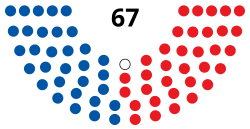Minnesota State Legislature
| Minnesota Legislature | |
|---|---|
| 90th Minnesota Legislature | |
 |
|
| Type | |
| Type | |
| Houses |
Senate House of Representatives |
| Leadership | |
| Structure | |
| Seats | 201 (67 senators, 134 representatives) |
 |
|
|
Senate political groups
|
|
 |
|
|
House of Representatives political groups
|
|
| Elections | |
|
Senate last election
|
November 8, 2016 |
|
House of Representatives last election
|
November 8, 2016 |
| Meeting place | |
 |
|
|
Minnesota State Capitol Saint Paul, Minnesota |
|
| Website | |
| www |
|
The Minnesota Legislature is the bicameral legislature of the U.S. state of Minnesota consisting of two houses: the Senate and the House of Representatives. Senators are elected from 67 single-member districts. In order to account for decennial redistricting, members run for one two-year term and two four-year terms each decade. They are elected for four-year terms in years ending in 2 and 6, and for two-year terms in years ending in 0. Representatives are elected for two-year terms from 134 single-member districts formed by dividing the 67 senate districts in half.
Both houses of the Legislature meet between January and the first Monday following the third Saturday in May each year, not to exceed 120 days per biennium. Floor sessions are held in the Minnesota State Capitol in Saint Paul.
Early on in the Minnesota's history, the Legislature had direct control over the city charters that set the groundwork for governments in municipalities across the state. In the early period, many laws were written for specific cities. The practice was outlawed in 1881, though attempts were still made. For instance, the long-standing Minneapolis Park and Recreation Board and the city's now defunct Library Board were both created by the Legislature in the next several years. The Minnesota Constitution was amended in 1896 to give cities direct control over their own charters.
In 1913, Minnesota legislators began to be elected on nonpartisan ballots. This was a historical accident that occurred when a bill to provide for no-party elections of judges, city, and county officers was amended to include the Legislature in the belief that it would kill the bill. While Minnesota legislators were elected on a nonpartisan ballot, they caucused as "Liberals" or "Conservatives," roughly the equivalent in most years to Democratic or Farmer–Labor (later Democratic–Farmer–Labor) and Republican, respectively. In 1974, House members again ran with party designation. In 1976, Senate members again ran with party designation.
...
Wikipedia
